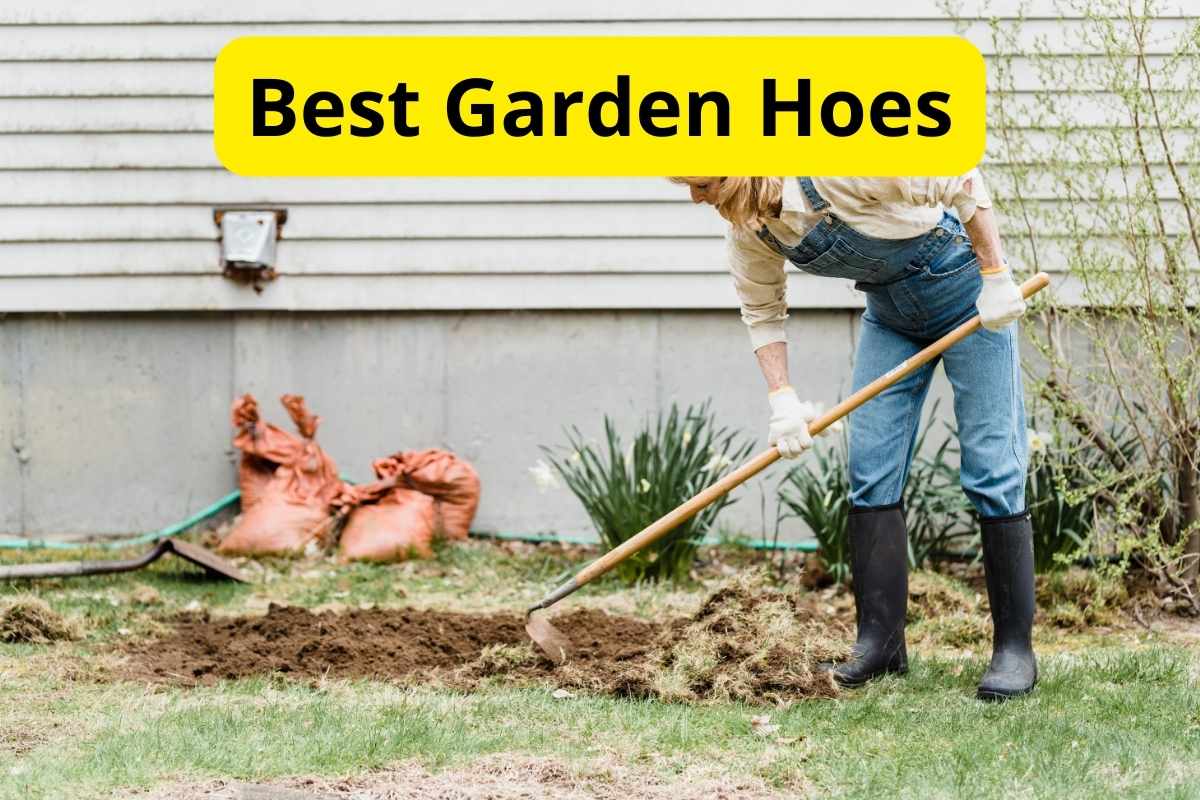
A garden hoe makes it easy to tend to your greenery, whether digging a row to plant your seedlings or ridding your flower beds of some weeds and wayward grass shoots, but which garden how is best for you?
Our list of the six best garden hoes will help narrow your options. We did the digging for you, so you don’t have to do a ton of garden hoe research before shopping online or at your neighborhood garden center.
Our six best garden hoes list includes six different types. Here’s a rundown — or in this case a hoe-down — of the six types of this popular garden tool.
So what makes the garden hoes different? It comes down to how you use them in the garden, but more on that in our buyers guide below.
Pro Tip: Some garden hoes may suit your needs better than others. If you’re tall, you’ll find that a short garden hoe is not the best tool for you. Likewise, if you’re not tall, you should avoid buying a garden hoe that’s too long. But don’t sweat –– our buyers guide will walk you through all the factors to consider before filling your shopping cart.
6 Top Garden Hoes [Reviews]
Each garden hoe listed is the top garden hoe of its type:
1. Best Draw Hoe: Bond Manufacturing LH004
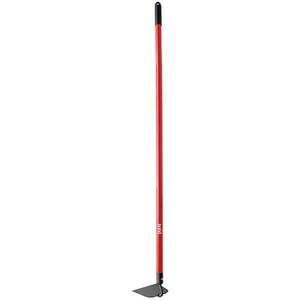
Bond Manufacturing LH004
The Bond Manufacturing LH004 is made of fiberglass and steel which makes it strong and lightweight.
Looking for a garden hoe that can handle all your gardening chores? The Bond Manufacturing LH004 draw hoe is your best bet.
What are draw hoes? Draw hoes are excellent garden tools for loosening compacted soil and tackling those large weeds. Just don’t go too overboard with the chopping –– if you’re not careful, you might wack one of your veggies!
The Bond Manufacturing LH004 has a fiberglass handle and tempered steel blade, so it’s durable. And unlike hardwood handles, moisture won’t damage the fiberglass handle. What this means: Whether you toss it in your truck or leave it in the rain, a fiberglass draw hoe can handle nearly any environment.
Not only is the Bond Manufacturing LH004 strong and durable, but it’s lightweight, too. As you chop away at the soil with its wide blade and lightweight design, your neck and shoulders won’t ache.
Specifications:
- Blade Material: Tempered Steel
- Handle Material: Fiberglass
- Handle Length: 54 inches
- Weight: 2.05 lbs
Pros:
✓ Tempered steel head for added strength
✓ Fiberglass handle
✓ Lightweight
✓ Cushioned grip for user-comfort
✓ Users praise its sturdy design
✓ Loosens soil and removes weeds
Cons:
✗ Expensive
✗ Some users report that they needed to sharpen the tool right out of the box.
1. Best Stirrup Hoe: True Temper 2866300
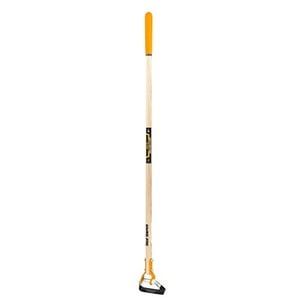
True Temper 2866300
The True Temper 2866300 has a cushioned hardwood handle and steel looped blade. It weighs about 2.5 lbs and is affordable.
The True Temper 2866300 is an excellent stirrup hoe to add to your toolshed. Weeds got your garden? Running a stirrup hoe through a weed-infested garden is a great way to clear up the earth without too much disruption to the soil.
What is a stirrup hoe? Also known as a scuffle hoe, a stirrup hoe has a looped blade that skims the soil’s surface and slices through weeds.
The True Temper 2866300’s hardwood handle may not have the same rot- and moisture-resistance as a fiberglass handle, but it does have its advantages. Many gardeners prefer the look and feel of natural hardwood, and the handle material is a great shock absorber. Wood handles are also easier to replace than fiberglass handles.
Bonus Points: This weeder won’t chop your wallet in half, and it comes with a cushioned grip for user comfort. Buyers report this stirrup hoe makes weeding fast and easy and that the tool lasts for years.
Specifications:
- Blade Material: Tempered Steel
- Handle Material: Hardwood
- Handle Length: 54 inches
- Weight: 2.55 lbs
Pros:
✓ Tempered steel blade for added strength
✓ Hardwood handle
✓ Affordable
Cons:
✗ Some users report the tool is heavy
1. Best Warren Hoe: Bully Tools 92354
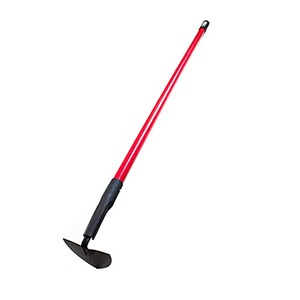
Bully Tools 92354
The Bully Tools 92354 comes with a limited lifetime warranty. It’s made of fiberglass and steel, but is still quite heavy.
Users praise the Bully Tools 92354 warren hoe for its high-quality material and superior strength.
But what exactly is a warren hoe? A warren hoe removes weeds and breaks up the soil. But here’s what sets it apart from the rest: The hoe’s heart-shaped blade helps gardeners create precise furrows or soil trenches for their seeds.
Bully Tools warren hoe boasts a thick 12-gauge steel blade, triple wall fiberglass handle, and cushioned grip.
Bonus points: When you buy from Bully Tools, your garden hoe comes with a limited lifetime warranty. If your hoe breaks during regular use, the company will replace or refund your tool.
Specifications:
- Blade Material: Steel
- Handle Material: Fiberglass
- Handle Length: 56
- Weight: 3.39 lbs
Pros:
✓ Thick 12-gauge steel blade
✓ Affordable
✓ Fiberglass handle
✓ Great length for tall users
✓ Cushioned grip for user-comfort
✓ Excellent blade shape for creating furrows in the garden
Cons:
✗ Heaviest tool on our list
✗ Not advertised as having tempered or carbon steel
1. Best Dutch Hoe: DeWit Dutch Long Handle Push Hoe
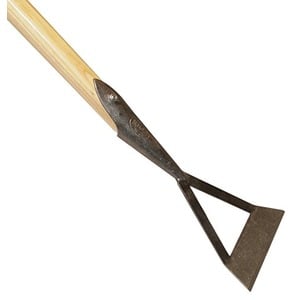
DeWit Dutch Long Handle Push Hoe
DeWit’s Dutch Long Handle Push Hoe has a 62″ wood handle, perfect for tall gardeners. It’s not cheap, but it’s high-quality.
If tool length has ever been a problem for you before, the 62-inch DeWit Dutch Push Hoe will give your shoulders and back a much-deserved break. The long handle allows tall users to weed their gardens while standing up straight.
So what’s a Dutch hoe? Like the stirrup hoe, the Dutch hoe is another type of scuffle hoe. Instead of having a typical 90-degree blade, the Dutch hoe blade faces forward.
A Dutch hoe blade often has a missing section in the center that’s sharpened on all sides. Gardeners skim the surface of the soil in a push-and-pull motion to sever the weeds without disrupting too much soil.
This DeWit Dutch hoe boasts a Swedish boron steel blade and a European ash hardwood handle. Bonus points: All DeWit handles come from government-controlled, Forest Stewardship Council (FSC) certified forests.
Despite the DeWit Dutch Hoe’s high price, many users report that this weeding tool is well worth their money.
Specifications:
- Blade Material: Boron Steel
- Handle Material: Ash
- Handle Length: 62 inches
- Weight: 2.05 lbs
Pros:
✓ Blade is made of boron steel
✓ Handle is made of ash, which is a strong hardwood
✓ Lightweight
✓ Superior length for tall users
Cons:
✗ Expensive
✗ Wooden handles are susceptible to decay, rot, and moisture damage.
1. Best Collinear Hoe: Bully Tools 92346
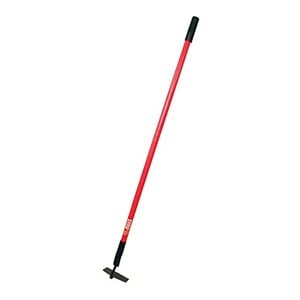
Bully Tools 92346 12-Gauge Nursery/Beet Hoe with Fiberglass Handle, 6-Inch by 2.5-Inch
Bully Tools 92346 is another great choice for tall users. It’s sturdy, affordable, and has a limited lifetime warranty.
Bully Tools brings home another blue ribbon for its fiberglass collinear hoe (92346). What’s so special about this hoe? The Bully Tools 92346 has a strong fiberglass handle and a thick 12-gauge steel blade. Its 57-inch long handle makes it a great choice for tall gardeners.
But what is a collinear hoe? The collinear hoe, also known as an onion hoe, is another type of scuffle hoe. Its long, thin, horizontal blade cuts through leaves without disturbing your plants. If your garden is full of prized veggies and fruits, you might like how the collinear hoe gives you more precision when weeding.
Specifications:
- Blade Material: Steel
- Handle Material: Fiberglass
- Handle Length: 57 inches
- Weight: 3 lbs
Pros:
✓ Thick 12 gauge steel blade
✓ Affordable
✓ Fiberglass handle
✓ Excellent length for tall users
✓ Cushioned grip for user-comfort
✓ Users praise the sturdiness of this hoe
✓ Limited lifetime warranty
✓ Blade shape provides precision while weeding
Cons:
✗ Some users report the tool is heavy
1. Best Multipurpose Garden Hoe and Cultivator: Edward Tools Hoe and Cultivator Hand Tiller
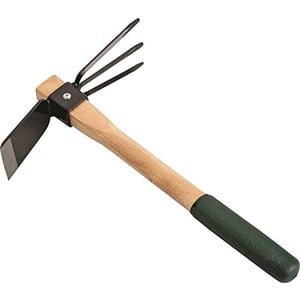
Edward Tools Hoe and Cultivator Hand Tiller
Edward Tools Hoe and Cultivator Hand Tiller is an all-in-one tool that loosens soil, cuts weeds, and digs small holes.
The Edward Tools Hoe and Cultivator Hand Tiller ranks No. 1 on our list for the best multipurpose garden hoe. It features a strong carbon steel blade and an ergonomic ash handle.
What is a multipurpose hoe? Multipurpose gardening tools save room in the storage shed and keep your wallet full. With a multipurpose tool, you’ll get two (or more) tools for the price of one.
The multipurpose design combines a garden hoe blade and three steel prongs to make one handy tool. What this means: Whether you need to loosen the soil, sever the weeds, or dig small holes, this hand tool can do the job.
Specifications:
- Blade Material: Carbon Steel
- Handle Material: Oak
- Handle Length: N/A
- Weight: 0.85 lbs
Pros:
✓ Multipurpose tool
✓ Hardwood handle
✓ Affordable
✓ Carbon steel blade and prongs
✓ Cushioned grip for user-comfort
✓ Loosens the soil, digs holes, and slices weeds
Cons:
✗ Some users report their tool breaking in half.
✗ Some users report the prongs bend.
✗ This is a handheld tool, not a full-length garden hoe.
✗ Wooden handles are susceptible to decay, rot, and moisture damage.
Buyers Guide
You’d think a garden hoe is just a garden hoe, but this valuable tool has several different designs, uses, and materials that can set one garden hoe apart from the rest.
First, a bit about the history of garden hoes: The garden hoe is an ancient tool. Once made of animal bones and stone, the garden hoe has evolved to feature metal blades, fiberglass handles, and various designs.
Slicing through hard soil and uprooting pesky weeds, a hoe remains popular among today’s gardeners.
Keep in mind that the best garden hoe for your neighbor might not be the best one for you. Your neighbor might like the durability of a fiberglass handle, but you might prefer the look and feel of a hardwood handle.
There are many different types of garden hoes, not just the traditional draw hoe. We’ve shown you six garden hoe types already, but we’ll review them once more down below so you can make the best decision for you and your vegetable patch.
Check out this video below featuring Bob Denman of Red Pig Tools explaining the different types of garden hoes:
Types of Garden Hoes
There are many different types of garden hoes. The six we have listed here are just the tip of the crabgrass. Their differences lie in the shape of the blade and its intended use.
Some garden hoes are better at tilling the ground and moving large sections of soil. Other garden hoes give you better precision so you can remove weeds without accidentally harming your plants — or your foot.
Draw Hoe
When you think of a garden hoe, you’re most likely thinking of a draw hoe with the traditional 90-degree blade. A draw hoe is a favorite tool for heavy-duty use –– it will take out tough weeds in your garden and slice through the soil like butter.
Keep in mind that a draw hoe is not ideal for tight spaces, so be careful working around your precious vegetable plants.
Stirrup Hoe
A stirrup hoe is a kind of scuffle hoe that resembles the appearance of a horse saddle’s stirrup. Scuffle hoes skim the soil’s surface and remove the weeds without disrupting too much soil.
Scuffle hoe blades have multiple sharp edges and don’t have the same shape as a draw hoe. Unlike a draw hoe, which you pull, you can use a scuffle hoe in a push-and-pull motion.
Warren Hoe
Warren hoes typically have a heart-shaped blade. The narrow tip of the blade helps gardeners build their furrows with ease. Furrows are the narrow soil trenches where gardeners plant their seeds.
Dutch Hoe
A Dutch hoe is another type of scuffle hoe. Like the stirrup hoe, the dutch hoe grazes the soil’s surface in a push-pull motion to uproot small weeds. The Dutch hoe blade consists of a missing section in the middle that’s sharpened on all sides for easy cutting.
Collinear Hoe
The collinear hoe, also known as an onion hoe, has a long, horizontal, narrow blade designed to remove weeds with precision. It’s an ideal hoe for weeding in tight spaces and is also a scuffle hoe.
Multipurpose Hoe
A multipurpose hoe is typically a handheld tool. If you’re a gardener shopping on a budget or who has little storage space, a multipurpose hoe may be of use to you. Most multipurpose hoes contain a traditional blade and sharp prongs that help move and till the soil.
Blade Material
Nearly every garden hoe on the market has a metal blade. The best garden hoes have steel blades, but not all steel blades are the same. Some steel types are stronger and more durable than others, while others are more resistant to rust.
The best blade for the job will ultimately come down to your budget, whether you want to deal with rust, and your preferred blade strength.
The four main types of steel we cover in this buyer’s guide are:
(Listed in order of most recommended)
Boron steel is steel alloyed with a small amount of the element boron (usually less than 1%). It’s the addition of boron that increases the steel’s strength. When ranking our garden hoes, we put the greatest weight on boron steel blades.
Tempered steel has been heat-treated to increase its toughness and resistance to stress before fracturing. Tempering is often performed on carbon steels.
Carbon steel is a common blade material you’ll find in a garden hoe. It’s more durable and expensive than stainless steel, but it does rust.
Stainless steel is rust-resistant, making it an easy metal to maintain. Stainless steel is an affordable choice, but it’s not as durable as the rest. When ranking the garden hoes, we placed the least amount of weight on stainless steel blades.
Handle Material
Garden hoe handles are traditionally hardwood. But in today’s market, gardeners can choose between many handle materials, including fiberglass, hardwood, aluminum, and steel.
(Listed in order of most recommended)
Fiberglass handles are a popular alternative to wood. Fiberglass is lightweight, durable, and shock-absorbent. Even better, fiberglass handles won’t rot and decay like wood, which means you can store your hoe nearly anywhere. Although fiberglass handles are not easy to replace, many manufacturers offer a lifetime warranty on their tools.
Hardwood garden hoe handles are durable and shock-absorbent. As a result, your neck and shoulders won’t have to bear the brunt each time you chop through the soil.
The disadvantage of wood is its susceptibility to rot and decay. Gardeners have to ensure their garden hoe is in a dry space each time they store it away. On the other hand, if your tool does begin to decay, a wood handle is easy to replace.
The best hardwood for your tool’s handle is hickory, with ash wood being a close second.
Aluminum is stronger than fiberglass and wood. It’s lightweight and corrosion-resistant, too, but it’s not going to protect your arms and shoulders against shock.
Steel is the strongest garden hoe handle you can find. However, it’s not as good a shock absorber as wood or fiberglass. Steel is also heavy, making garden chores a burden on tired muscles.
Handle Length
Before you commit to a garden hoe, make sure it feels comfortable in your hands. When using a garden hoe, you should be able to work while standing straight.
If you’re bending over, straining your back, or you feel unbalanced, chances are good the tool’s handle length is not ideal for your height.
Tool Weight
When testing out garden hoes in the store, you might notice that some feel heavier than others. The tool’s weight might not seem like an important factor when shopping around, but once you spend a few hours weeding the garden, your aching muscles will make you wish you had considered the tool’s weight.
If you traditionally opt for lightweight tools, it’s best to stick with a lightweight garden hoe, too.
User Comfort
Do your hands often hurt when working with gardening tools? You might benefit from tools designed with a cushioned grip. Many — but not all — garden hoes have a built-in cushioned grip at the end of the handle.
How We Measured
The best part about shopping for new tools is thinking about how they will enhance your garden. The last thing you want to do is hurt your brain thinking about specifications. That’s why we did the research for you.
We measured many different garden hoes by ranking their specifications in five different categories. We then took a weighted average of their ranked scores to determine the top six best garden hoes.
Blade Type: 35%
Handle Material: 35%
Cushioned Grip Included: 15% (Yes or No)
Cost: 10%
Item Weight: 5%
FAQs About Garden Hoes
A garden hoe is among the easiest tools to use in the garden. When hoeing, keep these helpful tips in mind:
— Stand up straight when using the tool. Your garden hoe should be long enough so that you don’t need to hunch your shoulders or bend forward.
— Hold the garden hoe in front of you, the same way you would hold a broom.
— Hold the garden hoe so that the hoe head will chop into the soil just below the surface.
— Depending on the type of garden hoe you have, pull the blade toward you in a sweeping motion or use the push-pull method.
— Use broad, sweeping motions when you hoe.
When you notice your garden hoe’s blade begins to dull, that doesn’t mean it’s time to replace the tool. Instead, sharpen the blade with a file.
A regular garden hoe allows gardeners to stand straight, whereas a short-handled hoe (measuring 10 to 12 inches long) requires users to bend over to work. The short-handled hoe was commonly used during the early 20th century in California’s sugar beet and lettuce fields.
Because the garden hoe was so short, it created dangerous working conditions. Child workers experienced chronic back pain and long-term effects as a result of such straining work.
Protests against the short-handled hoe began in the 1920s, but it wasn’t until 1975 that California became the first state to ban the short handle-hoe after the United Farm Workers of America (led by César E. Chávez) fought to eliminate it.
If You Don’t Enjoy Gardening, Hire a Pro
A garden hoe is a versatile tool and must-have for nearly every gardener. It loosens compacted soil, creates trenches for seeds, and even tackles weeds.
But remember, the best garden hoe for the job will depend on how you plan to use it. If you need a heavy-duty garden hoe that can sever weeds and move soil, then you might like a draw hoe. If you need to remove weeds fast without moving much soil, you might prefer a scuffle hoe.
Don’t want to spend the weekend removing weeds from the garden? We get it. After all, weeding is the least enjoyable part of owning a garden.
Instead of missing out on family memories and time with friends, hire a local lawn care professional to remove the weeds for you. A lawn care pro can also mow, fertilize, and treat weeds in your yard — improving your lawn’s health.
LawnStarter participates in the Amazon Services LLC Associates Program and other retailer affiliate programs. LawnStarter may earn revenue from products promoted in this article.
Main Image Credit: Pexels wih Text Overlay using Canva Pro